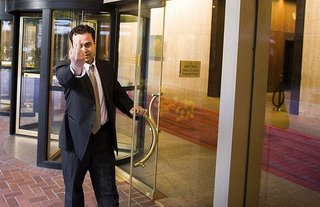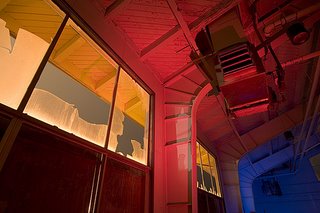|
simple is beautiful
Night Photography blog by Andy Frazer: April 2006
|
Saturday, April 29, 2006Digital Wallets
I just returned from vacation, so this blog hasn't been updated in the past week. But I've got at least a month's worth of material planned for near future, so the regular updates will continue very soon.
One item that I'd like to mention is the Epson P-2000 multimedia storage device (above). When you're traveling with a digital camera, you're going to run into the problem of storing all of your photographs. One option is to buy lots of flash cards (too expensive and too difficult to view images, for me). Another option is to bring a device that burns data from your flash cards to DVD's (but you can't review them without a computer). The most popular option is to bring a laptop computer (too heavy, for me). The fourth option is buy a small device specifically designed to download the images from the flash cards onto a hard drive that's connected to a small LCD screen (basically, it's a very small PC without the general purpose operating system). When digital cameras took off around 2000-2001, there were a number of devices like this available. But most of them either 1). lacked a good screen to review the images (think "no screen"), 2). had limited battery life (think "one memory card per battery charge"), 3). were plagued with reliability problems (think "they lost my photographs"), or 4). came with unacceptable customer service from the manufacturer (as in, "they won't return your call when the data gets corrupted"). Most of the professional photographers who gave glowing reviews of these devices printed retractions within one year, after having lost some valuable images. The first product that overcame these problems was the Epson P2000, which was made by an established company (Epson), had lots of disk space (40GB) and one of the most brilliant monitors ever seen (although it's 3.8-inches). Micheal Reichmann gave it a glowing review on the Luminous Landscape (and he should know, he had been burned before by some of the similar products that were available before the P-2000). The P2000 has since been upgraded to an 80GB device with a slightly larger screen. Micheal Johnston said that the screen was so good, that he wondered why Epson couldn't build a full-size monitor with this quality. Unfortunately, I can't find that article on either the Luminous Landscape or Micheal Johnston's personal blog. I've taken an Epson P-2000 on vacation three times. I've never had a single problem with it, and I still haven't filled up those 40GB's of disk. And the screen is so good, that I never get tired of reviewing my photographs over and over while I'm flying home. Thursday, April 20, 2006Luminous Landscape
There are many resources on the internet that could be of interest to night photographers, even though their content is not specifically directed at night photography, abandoned buildings or evading security guards.
I think the most useful all-encompassing photographic resource on the internet is Michael Reichmann's Luminous Landscape website. I've been checking this site almost every day for the past five years, and I never get tired of his personal photo projects, workshop updates, featured columnists and (for all you gear-heads out there) product updates. Although most of Michael's photography involves either landscapes or nature, he also has a background as a documentary photographer. Unlike equipment-oriented sites (such as DPReview), Michael's equipment reviews focus on real-world usability (how does the equipment feel? is it responsive? are the menus easy to navigate? what do the prints look like? how many pixels are enough?). It's no secret that Michael prefers digital to film. He took a lot of heat when he first declared that 35mm-class digital cameras produce superior images to 35mm film cameras. In fact, it was Michael's review of the Canon D60 back in the Spring of 2002 that convinced me to take the plunge and move over to the "Dark Side". Specifically (and, now back to night photography...), I was waiting for a digital camera that could take exposures at least four minutes, which is the minimum exposure length to record a decent single exposure under a full moon. The D60 did it four years ago, and I still use that camera for all of my night work, today. Lately, Michael has been reviewing the state-of-the-art medium format backs, which are now producing on the order of 40 megapixels. These reviews make for great reading, although they are well out of the price range of most photographers. He has even gone so far as to compare these digital back with large-format film, and (gasp) he has even hosted articles by other photographers comparing the Canon 1Ds-MkII with large format film! Wednesday, April 19, 2006Security Guards
Night photographers, as a group, seem to be attracted to photographing buildings on the edge of civilization: abandoned buildings, fenced-off buildings, and, generally, locations that we're just not supposed to be inside. In today's paranoid world, it's not unusual to run into mainstream buildings that someone thinks you're not supposed to photograph because... well... because some people feel like they're doing their part to help national security by trying to stop you.
It's all a bit silly, but some people feel they need to do something to stomp out evil. Read Thomas Hawk's encounter with a security guard when he tried to photograph a modern office building in San Francisco. This incident is different than previous stories you may have heard about poor-little-photographers trying to take a snapshot of an office building. In Thomas' case (not his real name), he photographed the security boss flipping him off. His photograph is now part of the Flickr "GFY" group :-) Monday, April 17, 2006Lost America
Back when night photography was so esoteric that nobody even talked about night photography, Troy Paiva was developing a method to light up buildings at night with colored gels and a hand-held flash. He spent years photographing abandoned towns and mines across the southwest
(photo: One of Which brings me to another shameless plug for one of my projects… Sunday, April 16, 2006Petaluma
Sometimes an image from another photographer gets etched into my brain, and it shows up as an influence in one of my shots. A few years ago, Lance Keimig had a gallery show, and he sent me one of those announcement that looks like a large postcard. It was a photograph of the
(photo: Lance Keimig) About a year later I was photographing the old waterfront in Above is Lance’s shot. Below is mine. Most people have told me they don’t see any similarity. But, to me, it’s obvious. Friday, April 14, 2006Lance Keimig
Lance Keimig, along with Tim Baskerville, was one of my original night photography instructors four years ago. Lance is a great black-and-white printer, and has a wonderful eye for composition and dark, moody images. He regularly shoots in
Lance is currently teaching night photography workshops at the New England School of Photography (NESOP). You can also hear Lance talk about his work in my (here comes the shameless plug…) night photography documentary film. Mare Island During last month’s full moon, I photographed The base is crawling with security guards at night. I was stopped by one guard while I was shooting the above shot. He told me that the empty building behind me had been the target of numerous copper thieves, so I guess I had walked right into “high patrol” zone. To top that off, one hour later I accidentally set off a screaming motion detector alarm when I wandered too far up a dark alley looking for some sort of film noir shot. It was a good thing that Tim had arranged special permission for us to be there after dark. In the shot above, the yellow and the greenish lights are from nearby street lights and security lights. I added the red light underneath the walkbridge using a hand-held flash and a red gel. Thursday, April 13, 2006The Nocturnes (photo: Tim Baskerville) "Surrealism,the mystery of place, - Tim Baskerville For years, The Nocturnes website has been the largest resource of night photography on the internet. Originally founded inI took my first night photography workshop through The Nocturnes at Above is one of Tim Baskerville’s photographs from Wednesday, April 12, 2006Welcome to my blog
Welcome to my (new) night photography blog.
Night photography has been my passion for the past seven years. I have my own night photography website, a night photography documentary film, and a night photography Flickr account (all of which I'll drag you to, in due time). I obsess about night photography. Now, I want to burden the rest of the world with my obsession. In this blog I will post night photographs of my own; my cohorts-in-crime; some famous night photographers; and sometimes anything I come across on the internet. Occasionally, I'll post something that's only marginally related to night photography. But even that should be of interest to everyone. Technically, this is my second night photography blog. I began the first one a year ago. Instead of using proven blogging tools, such as Blogger, I tried to create my own blog in HTML and upload it every night. Big mistake! After about twenty posts, I got tired of editing the HTML every night, and I let it die quietly. This one will be different. I'd like to start by paying homage to, what I believe is, the world's first night photography blog: NightHawks, which is moderated by one of my fellow Nocturnes: Mark Interrante. Mark is a big-wig at one of the world's largest internet portals, and he had enough foresight to recognize the potential of blogs. So, hat's off to Mark! For all you Flickr fans, Mark's Flickr name is Pinhole. Thanks for stopping by. Andy Frazer
Subscribe to:
Comments (Atom)
|
|







